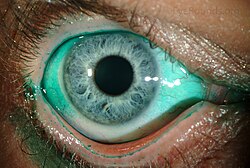Dry eyes
| Dry eye syndrome | |
|---|---|
| Synonyms | dry eye, keratoconjunctivitis sicca, dry eye disease, keratitis sicca |
 |
|
| Diffuse lissamine green staining in a person with severe dry eye. | |
| Classification and external resources | |
| Specialty | ophthalmology |
| ICD-10 | H19.3 |
| ICD-9-CM | 370.33 |
| MedlinePlus | 000426 |
| eMedicine | article/1196733 article/1210417 |
| MeSH | D007638 |
Dry eye syndrome (DES), also known as keratoconjunctivitis sicca (KCS), is the condition of having dry eyes. Other associated symptoms include irritation, redness, discharge, and easily fatigued eyes. Blurred vision may also occur. The symptoms can range from mild and occasional to severe and continuous. Scarring of the cornea may occur in some cases without treatment.
Dry eye occurs when either the eye does not produce enough tears or when the tears evaporate too quickly. This can result from meibomian gland dysfunction, allergies, pregnancy, Sjogren's syndrome, vitamin A deficiency, LASIK surgery, and certain medications such as antihistamines, some blood pressure medication, hormone replacement therapy, and antidepressants. Chronic conjunctivitis such as from tobacco smoke exposure or infection may also lead to the condition. Diagnosis is mostly based on the symptoms though a number of other tests may be used.
Treatment depends on the underlying cause. Artificial tears are the usual first line treatment. Wrap around glasses that fit close to the face may decrease tear evaporation. Stopping or changing certain medications may help. The medication ciclosporin or steroid eye drops may be used in some cases. Another option is lacrimal plugs that prevent tears from draining from the surface of the eye. Dry eyes occasionally makes wearing contact lenses impossible.
...
Wikipedia
